- United States Population
- United States Population by Age
- United States Population by Gender
- United States Population by Race & Ethnicity
- United States Population by Year

United States population by race
The table below shows United States's population by race.
TABLE OF CONTENTS
Racial / Ethnic makeup of United States
Things to know.
Of the 5 race categories (excluding ethnicity) identified by the Census Bureau, namely American Indian or Alaska Native, Asian, Black or African American, Native Hawaiian or Other Pacific Islander and White; United States has a population in all of the race categories.
This confirms that United States's population has become increasingly diverse.
The percent distribution of United States population by race (across all racial categories recognized by the U.S. Census Bureau): 68.17% are White, 12.55% are Black or African American, 0.83% are American Indian and Alaska Native, 5.70% are Asian, 0.19% are Native Hawaiian and other Pacific Islander, 5.58% are some other race and 6.99% are multiracial.

United States's racial breakdown clearly shows that there is an absolute majority (i.e. more than 50% of the population belong to one particular race) of White population in the country.
As per the latest data estimates from American Community Survey's 5-year estimates:
1. The largest racial group in United States is White with a population of 224.79 million (68.17% of the total population).
2. The multiracial population, i.e. population that identify themselves with two or more races, is 23.04 million (6.99% of the total population).
By ethnicity, 60.81 million (18.44% of the total population) is Hispanic or Latino (of any race), and 268.92 million (81.56% of the total population) is Non-Hispanic.

Of the Non-Hispanic population in United States, the largest racial group is White alone with a population of 196.01 million (72.89% of the total Non-Hispanic population).
United States Non-Hispanic population by race
The distribution of the Non-Hispanic population across various race categories
Among the Hispanic population in United States, regardless of the race, the largest group is of Mexican origin, with a population of 36.98 million (60.82% of the total Hispanic population).
United States Hispanic or Latino population
The distribution of the Hispanic or Latino population by their ancestries
What percentage of United States is Hispanic?
As per the U.S. Census Bureau American Community Survey estimates, 18.44% of United States population is Hispanic.
How many Black people does United States have?
United States has 41.39 million Black or African American population as per the estimates from the latest American Community Survey 5-Year estimates. Overall 12.55% of the total population (excluding multiracial) in United States is Black.
What is the largest minority group in United States?
With 18.44% of the total population, Hispanic and Latino Americans are the largest ethnic minority in United States.
That being said, with a 12.55% of the total population, Black or African Americans are the largest racial minority in United States.
What is the majority race in United States?
With a population of 224.79 million (68.17% of the total population), Whites are the largest racial majority in United States.
Black or African Americans are second largest race in United States, with 12.55% of the total population.
- U.S. Census Bureau American Community Survey (ACS) 2017-2021 5-Year Estimates
About this dataset
The dataset tabulates the population of United States by race. It includes the population of United States across racial categories (excluding ethnicity) as identified by the Census Bureau. The dataset can be utilized to understand the population distribution of United States across relevant racial categories.
Key observations
The percent distribution of United States population by race (across all racial categories recognized by the U.S. Census Bureau): 68.17% are white, 12.55% are Black or African American, 0.83% are American Indian and Alaska Native, 5.70% are Asian, 0.19% are Native Hawaiian and other Pacific Islander, 5.58% are some other race and 6.99% are multiracial.

When available, the data consists of estimates from the U.S. Census Bureau American Community Survey (ACS) 2017-2021 5-Year Estimates.
Racial categories include:
- Black or African American
- American Indian and Alaska Native
- Native Hawaiian and Other Pacific Islander
- Some other race
- Two or more races (multiracial)
Variables / Data Columns
- Race: This column displays the racial categories (excluding ethnicity) for the United States
- Population: The population of the racial category (excluding ethnicity) in the United States is shown in this column.
- % of Total Population: This column displays the percentage distribution of each race as a proportion of United States total population. Please note that the sum of all percentages may not equal one due to rounding of values.
Good to know
Margin of Error
Data in the dataset are based on the estimates and are subject to sampling variability and thus a margin of error. Neilsberg Research recommends using caution when presening these estimates in your research.
Custom data
If you do need custom data for any of your research project, report or presentation, you can contact our research staff at [email protected] for a feasibility of a custom tabulation on a fee-for-service basis.
Inspiration
Neilsberg Research Team curates, analyze and publishes demographics and economic data from a variety of public and proprietary sources, each of which often includes multiple surveys and programs. The large majority of Neilsberg Research aggregated datasets and insights is made available for free download at https://www.neilsberg.com/research/ .
Recommended for further research
This dataset is a part of the main dataset for United States Population by Race & Ethnicity. You can refer the same here
The dataset tabulates the Non-Hispanic population of United States by race. It includes the distribution of the Non-Hispanic population of United States across various race categories as identified by the Census Bureau. The dataset can be utilized to understand the Non-Hispanic population distribution of United States across relevant racial categories.

- Race: This column displays the racial categories (for Non-Hispanic) for the United States
- Population: The population of the racial category (for Non-Hispanic) in the United States is shown in this column.
- % of Total Population: This column displays the percentage distribution of each race as a proportion of United States total Non-Hispanic population. Please note that the sum of all percentages may not equal one due to rounding of values.
The dataset tabulates the United States Hispanic or Latino population. It includes the distribution of the Hispanic or Latino population, of United States, by their ancestries, as identified by the Census Bureau. The dataset can be utilized to understand the origin of the Hispanic or Latino population of United States.
Origin for Hispanic or Latino population include:
- Puerto Rican
- Other Hispanic or Latino
- Origin: This column displays the origin for Hispanic or Latino population for the United States
- Population: The population of the specific origin for Hispanic or Latino population in the United States is shown in this column.
- % of Total Hispanic Population: This column displays the percentage distribution of each Hispanic origin as a proportion of United States total Hispanic or Latino population. Please note that the sum of all percentages may not equal one due to rounding of values.
Explore more
About the author.
- Skip to main content
- Keyboard shortcuts for audio player
What The New Census Data Shows About Race Depends On How You Look At It
Connie Hanzhang Jin
Ruth Talbot

Hansi Lo Wang
Over the past decade, the United States continued to grow more racially and ethnically diverse, according to the results of last year's national head count that the U.S. Census Bureau released this week.
There are many ways to slice the data and change how the demographic snapshot looks .
Since the 2000 count, participants have been able to check off more than one box when answering the race question on census forms . But breakdowns of the country's racial and ethnic makeup often don't reflect a multiracial population that has increased by 276% since the 2010 census . They focus instead on racial groups that are made up of people who marked only one box, with multiracial people sometimes lumped together in a catchall group.
Using the new 2020 census results, here's what a breakdown with a catchall group for multiracial people looks like:
But a different kind of breakdown can show how racial groups are becoming more heterogeneous. This graphic shows the number of people who said they identified with each race, regardless of how many races they chose. For example, if a person said they identified as Black and Asian, they would appear in both racial categories.
And there are other ways, of course, to slice the data, including incorporating people who identify as Hispanic or Latino — and who, according to federal standards , can be of any race — into the different racial groups.
To make matters more complicated, research by the Census Bureau has shown that how some people self-report their racial and ethnic identity can change from census to census.
Any analysis of this data represents a different way of understanding race and ethnicity in the U.S., where count after count people have made clear that their identities often cannot fit neatly into check boxes on census forms.
- Coronavirus
- Demographics
United States Demographics
Dependency ratio.
- Fertility Rate
- Life Expectancy
- Infant and Children under 5 Mortality
- Urbanization and Population Density
- [ Sources and more info ]
Population of the United States (2023)
View live population, charts & trends: Population of the United States
The median age in the United States is 38.1 years (2023).
Fertility in the U.S.A.
A Total Fertility Rate (TFR) of 2.1 represents the Replacement-Level Fertility : the average number of children per woman needed for each generation to exactly replace itself without needing international immigration. A value below 2.1 will cause the native population to decline
Life Expectancy in the U.S.A.
See also: Countries in the world ranked by Life Expectancy
Infant Mortality Rate and Deaths of Children under 5 Years Old in the U.S.A.
United states urban population, population density.
The 2023 population density in the United States is 37 people per Km 2 (96 people per mi 2 ), calculated on a total land area of 9,147,420 Km2 (3,531,837 sq. miles).
Largest Cities in the U.S.A.
- Population of the United States
- GDP (Gross Domestic Product) of the United States
- Demographics of Northern America
- World Demographics
- World Population Prospects: The 2022 Revision - United Nations Population Division
- World Urbanization Prospects - Population Division - United Nations
- United Nations Statistics Division
- Organisation for Economic Co-operation and Development (OECD)
Definitions
Population pyramid.
A Population pyramid (also called "Age-Sex Pyramid") is a graphical representation of the age and sex of a population.
- Expansive - pyramid with a wide base (larger percentage of people in younger age groups, indicating high birth rates and high fertility rates) and narrow top (high death rate and lower life expectancies). It suggests a growing population. Example: Nigera Population Pyramid
- Constrictive - pyramid with a narrow base (lower percentage of younger people, indicating declining birth rates with each succeeding age group getting smaller than the previous one). Example: United States
- Stationary - with a somewhat equal proportion of the population in each age group. The population is stable, neither increasing nor decreasing.

There are three types of age dependency ratio: Youth, Elderly, and Total. All three ratios are commonly multiplied by 100. Youth Dependency Ratio Definition: population ages 0-15 divided by the population ages 16-64. Formula: ( [Population ages 0-15] ÷ [Population ages 16-64] ) × 100
Elderly dependency ratio Definition: population ages 65-plus divided by the population ages 16-64. Formula: ( [Population ages 65-plus] ÷ [Population ages 16-64] ) × 100
Total dependency ratio Definition: sum of the youth and old-age ratios. Formula: (( [Population ages 0-15] + [Population ages 65-plus] ) ÷ [Population ages 16-64] ) × 100
NOTE: Dependency Ratio does not take into account labor force participation rates by age group. Some portion of the population counted as "working age" may actually be unemployed or not in the labor force whereas some portion of the "dependent" population may be employed and not necessarily economically dependent.
- Society ›
Demographics
U.S. population by sex and age 2022
Which u.s. state has the largest population, the u.s. population by race and ethnicity, resident population of the united states by sex and age as of july 1, 2022 (in millions).
Additional Information
Show sources information Show publisher information Use Ask Statista Research Service
United States
As of July 1, 2022
Excludes Armed Forces overseas. Values have been rounded.
Other statistics on the topic Demographics in the U.S.
- U.S. population of metropolitan areas in 2022
Population of the U.S. by race 2000-2022
- Population in the states of the U.S. 2022
- U.S. population by generation 2022

- Immediate access to statistics, forecasts & reports
- Usage and publication rights
- Download in various formats
You only have access to basic statistics.
- Instant access to 1m statistics
- Download in XLS, PDF & PNG format
- Detailed references
Business Solutions including all features.
Statistics on " Demographics of the U.S. Part I "
- Total population of the United States 2027
- Population growth in the U.S. 2022
- Population density in the U.S. 2021, by state
- Largest counties in the U.S. 2022
- Urbanization in the United States 1790 to 2050
- Number of births in the United States 1990-2021
- United States - birth rate 1990-2021
- Birth rate by age of mother in the U.S. 2021
- Birth rate by ethnic group of mother in the U.S. 2022
- Birth rate by educational attainment of mother in the U.S. 2022
- Birth rate by family income in the U.S. 2019
- Percentage of childless women U.S. 2020, by age
- U.S. - Infant mortality rate 1990-2021
- U.S. total number of fatalities 1990-2022
- U.S. total death rate 1990-2020
- Death rate by age and sex in the U.S. 2020
- Death rate by ethnic group and sex in the U.S. 2020
- Births and deaths in the U.S. by state 2020
- Life expectancy in the United States 2021
- Life expectancy of men in the United States 2021
- Life expectancy of women in the United States 2011-2021
Other statistics that may interest you Demographics of the U.S. Part I
- Basic Statistic Total population of the United States 2027
- Premium Statistic U.S. population by generation 2022
- Basic Statistic Population growth in the U.S. 2022
- Basic Statistic Population in the states of the U.S. 2022
- Basic Statistic Population density in the U.S. 2021, by state
- Basic Statistic U.S. population of metropolitan areas in 2022
- Basic Statistic Largest counties in the U.S. 2022
- Basic Statistic Urbanization in the United States 1790 to 2050
Births, birth rate, infant mortality
- Basic Statistic Number of births in the United States 1990-2021
- Basic Statistic United States - birth rate 1990-2021
- Basic Statistic Birth rate by age of mother in the U.S. 2021
- Basic Statistic Birth rate by ethnic group of mother in the U.S. 2022
- Basic Statistic Birth rate by educational attainment of mother in the U.S. 2022
- Basic Statistic Birth rate by family income in the U.S. 2019
- Basic Statistic Percentage of childless women U.S. 2020, by age
- Basic Statistic U.S. - Infant mortality rate 1990-2021
Deaths, death rate, life expectancy
- Premium Statistic U.S. total number of fatalities 1990-2022
- Premium Statistic U.S. total death rate 1990-2020
- Basic Statistic Death rate by age and sex in the U.S. 2020
- Basic Statistic Death rate by ethnic group and sex in the U.S. 2020
- Basic Statistic Births and deaths in the U.S. by state 2020
- Basic Statistic Life expectancy in the United States 2021
- Basic Statistic Life expectancy of men in the United States 2021
- Basic Statistic Life expectancy of women in the United States 2011-2021
Further related statistics
- Basic Statistic Global age distribution by region 2022
- Basic Statistic Number of people living in Marseille, France 2020, by age
- Basic Statistic Distribution of the population living in Marseille, France 2020, by age
- Basic Statistic Middle aged UK population projection 2020-2050, by age group
- Basic Statistic U.S. population projection for 2015 and 2060, by age
- Basic Statistic Youth population of the United Kingdom 2020-2050 by age
- Basic Statistic Global population distribution by age and region 2022
- Basic Statistic Population density in Florida 1960-2018
- Premium Statistic Population of Cantabria in 2023, by age group
- Premium Statistic Population of Extremadura in 2023, by age group
- Premium Statistic Population of Melilla in 2023, by age group
- Premium Statistic Afghan nationals population of the UK 2008-2021
- Premium Statistic Wealth per adult in India 2000-2020
- Premium Statistic Ukrainian nationals population of the UK 2009-2021
- Premium Statistic World's heaviest countries 2012
- Premium Statistic Heat transfer coolers: U.S. shipment value 2009-2010
Further Content: You might find this interesting as well
- Global age distribution by region 2022
- Number of people living in Marseille, France 2020, by age
- Distribution of the population living in Marseille, France 2020, by age
- Middle aged UK population projection 2020-2050, by age group
- U.S. population projection for 2015 and 2060, by age
- Youth population of the United Kingdom 2020-2050 by age
- Global population distribution by age and region 2022
- Population density in Florida 1960-2018
- Population of Cantabria in 2023, by age group
- Population of Extremadura in 2023, by age group
- Population of Melilla in 2023, by age group
- Afghan nationals population of the UK 2008-2021
- Wealth per adult in India 2000-2020
- Ukrainian nationals population of the UK 2009-2021
- World's heaviest countries 2012
- Heat transfer coolers: U.S. shipment value 2009-2010
Sorry, we did not find any matching results.
We frequently add data and we're interested in what would be useful to people. If you have a specific recommendation, you can reach us at [email protected] .
We are in the process of adding data at the state and local level. Sign up on our mailing list here to be the first to know when it is available.
Search tips:
• Check your spelling
• Try other search terms
• Use fewer words
From the American standard of living to immigration statistics to government finances: explore the data for a broader understanding of how the government spends its time and your money. Compare historical trends, dig deep into the numbers, and interact with visualizations designed to give you a better idea of government’s impact on the nation and its people.
Government Finances
Security & safety, people & society, sign up for the newsletter, data delivered to your inbox.
Keep up with the latest data and most popular content.
Got any suggestions?
We want to hear from you! Send us a message and help improve Slidesgo
Top searches
Trending searches

teacher appreciation
11 templates

memorial day
12 templates

13 templates

rain forest
23 templates

amusement park
5 templates
Demographic Infographics
Free google slides theme, powerpoint template, and canva presentation template.
Demographic infographics are useful when you want to share the results of some analyses related to people: percentages related to the age, hobbies, location and the like of a group of people. Use them for business or marketing purposes! We have included maps, pie charts, bar graphs, diagrams of people or area charts. There are plenty of possibilities.
Features of these infographics
- Different designs to share demographic data
- 100% editable and easy to modify
- 31 different infographics to boost your presentations
- Include icons and Flaticon’s extension for further customization
- Designed to be used in Google Slides, Canva, and Microsoft PowerPoint and Keynote
- 16:9 widescreen format suitable for all types of screens
- Include information about how to edit and customize your infographics
How can I use the infographics?
Am I free to use the templates?
How to attribute the infographics?
Attribution required If you are a free user, you must attribute Slidesgo by keeping the slide where the credits appear. How to attribute?
Related posts on our blog.

How to Add, Duplicate, Move, Delete or Hide Slides in Google Slides

How to Change Layouts in PowerPoint

How to Change the Slide Size in Google Slides
Related presentations.

Premium template
Unlock this template and gain unlimited access

Demographic Snapshot – Charts for PowerPoint

Dashboard , Data visualization , Data-driven , Demographics , Female , Male , Quantitative Results
Free demographic infographic chart for PowerPoint. 1-slide snapshot template to visualize your demographic data. Editable graphics and data-driven charts.
Demographic Snapshot
If you are a Market Research consultant or analyst, you probably asked yourself at least once that question: “How can I describe and summarize my sample (population) in one visually-appealing slide?”
PresentationGO made it easy for you! This template slide combines different data-driven charts – like doughnut pie charts, bar charts, to make your demographic data nicely presented.
Shapes are 100% editable : colors and sizes can be easily changed.
Includes 2 slide option designs: Standard (4:3) and Widescreen (16:9).
Widescreen (16:9) size preview:

This ‘Demographic Snapshot – Charts for PowerPoint’ features:
- 2 unique slides
- Light and Dark layout
- Ready to use template with text placeholders
- Completely editable shapes
- Data-driven charts
- Standard (4:3) and Widescreen (16:9) aspect ratios
Free fonts used:
- Helvetica (System Font)
- Calibri (System Font)
Terms of use:
Requires attribution, personal and educational use, commercial use, (re)sell, (re)distribute, read the full terms of use.
Comments are closed.
You may also like these presentation templates

Search Templates by categories
Search templates by colors.
Love our templates? Show your support with a coffee!
Thank you for fueling our creativity.
Charts & Diagrams
Text & Tables
Graphics & Metaphors
Timelines & Planning
Best-Ofs & Tips
Terms and Conditions
Privacy Statement
Cookie Policy
Digital Millennium Copyright Act (DMCA) Policy
© Copyright 2024 Ofeex | PRESENTATIONGO® is a registered trademark | All rights reserved.

To provide the best experiences, we and our partners use technologies like cookies to store and/or access device information. Consenting to these technologies will allow us and our partners to process personal data such as browsing behavior or unique IDs on this site and show (non-) personalized ads. Not consenting or withdrawing consent, may adversely affect certain features and functions.
Click below to consent to the above or make granular choices. Your choices will be applied to this site only. You can change your settings at any time, including withdrawing your consent, by using the toggles on the Cookie Policy, or by clicking on the manage consent button at the bottom of the screen.
Thank you for downloading this template!
Remember, you can use it for free but you have to attribute PresentationGO . For example, you can use the following text:
If you really like our free templates and want to thank/help us, you can:
Thank you for your support

Researched by Consultants from Top-Tier Management Companies

Powerpoint Templates
Icon Bundle
Kpi Dashboard
Professional
Business Plans
Swot Analysis
Gantt Chart
Business Proposal
Marketing Plan
Project Management
Business Case
Business Model
Cyber Security
Business PPT
Digital Marketing
Digital Transformation
Human Resources
Product Management
Artificial Intelligence
Company Profile
Acknowledgement PPT
PPT Presentation
Reports Brochures
One Page Pitch
Interview PPT
All Categories
Top 10 Demographics PowerPoint Templates with Samples and Examples
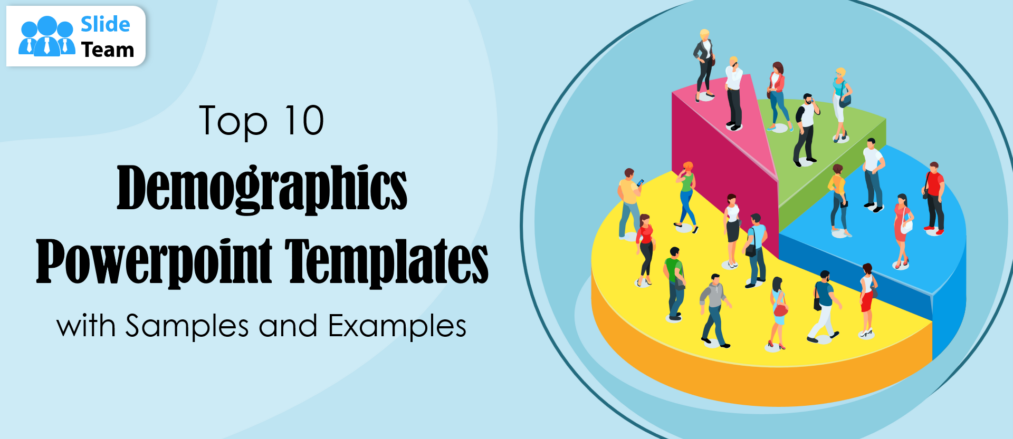
Pratibimb Shukla
Demographics are the key to business success. Imagine that your target audience's requirements, interests, and behaviours are vividly depicted by data points. Yet, the common thread that gives a nuanced picture of consumer preferences may be seen in the demographics, ranging from quiet suburban streets to busy metropolises. For instance, children or kids? Staid 40s or the adventurous 30s, and so on.
Now, picture yourself as a tourist exploring an unexplored country. Would you want a lighthouse, compass, or map to lead the way?
Businesses may use demographic data as a helpful instrument to help them understand better and meet customer wants and industry trends. It serves as the cornerstone for product creation, the basis for marketing strategy, and the compass for corporate growth. Businesses may optimize relevance, harmony, and resonance by tailoring their services based on a comprehensive understanding of their audience's age, gender, income, education level, and other factors. In essence, demographic information is the lifeblood of the business, teeming with ideas, prospects, and development potential. It is more than simply figures on a spreadsheet.
Make precise decisions by delving into demographics, developing surveys, utilizing dashboards, and illuminating your professional path with our Top Demographic Dashboard Templates.
Please tour the ever-changing demographic environment with our top demographics PowerPoint Templates. Knowing your audience is not just a competitive advantage in the digital era of strategic competencies but also the cornerstone of success. Our PPT Templates guide users through striking visual representations of age, gender, income, and other variables, giving them this priceless knowledge. These slides, which range from captivating charts to perceptive infographics, convert data into insights that help customers develop focused marketing campaigns, improve the delivery of their goods, and foster company expansion.
Let’s explore the potential of demography as we help you map out your success!
Template 1: Company employees' demographics over the years PowerPoint Template
This PPT Template offers an eye-catching method to present the gender, age, and race/ethnicity of your company's workforce over time. Every component in this template is intended to give your presentation a polished appearance. Age demographics offer information on development potential and the generational mix, gender analysis aids in understanding the harmony of diversity, and race/ethnicity emphasizes integration within the organization. Users gain from this overview since it offers a concise, aesthetically pleasing summary of shifting business demographics and enriches presentations with insightful data. Get it Now!
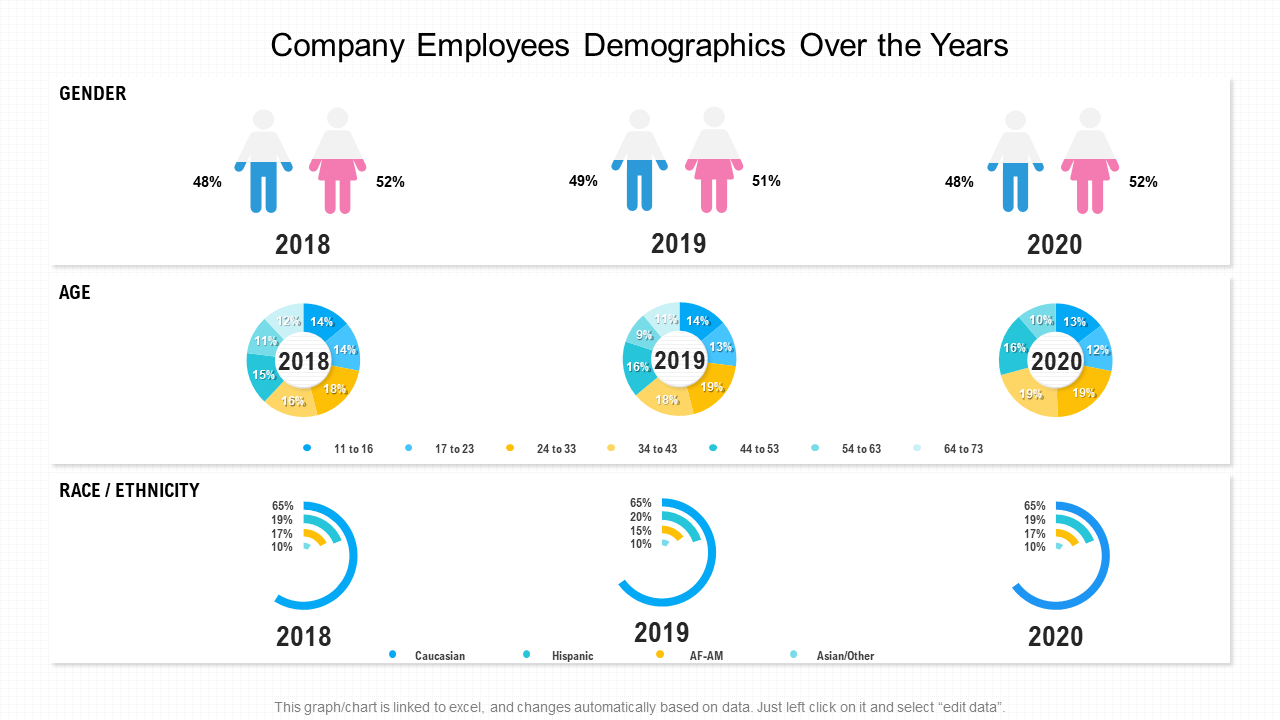
Download Now
Template 2: Employee Demographics and Gender Distribution Dashboard PowerPoint Template
This PPT Template presents a thorough overview of the dynamics and face of your company. This template focuses on staff rotation, recruiting, and gender breakdown. By providing a visual analysis of the workforce, the Gender Analysis section promotes diversity awareness. Gender-based recruiting sheds light on hiring patterns and aids in evaluating the fairness of hiring procedures. Gender-specific turnover sheds insight into retention issues and helps identify which groups are impacted. Users may benefit from the valuable information this preset offers to support a fair and inclusive workplace. Grab it Now!
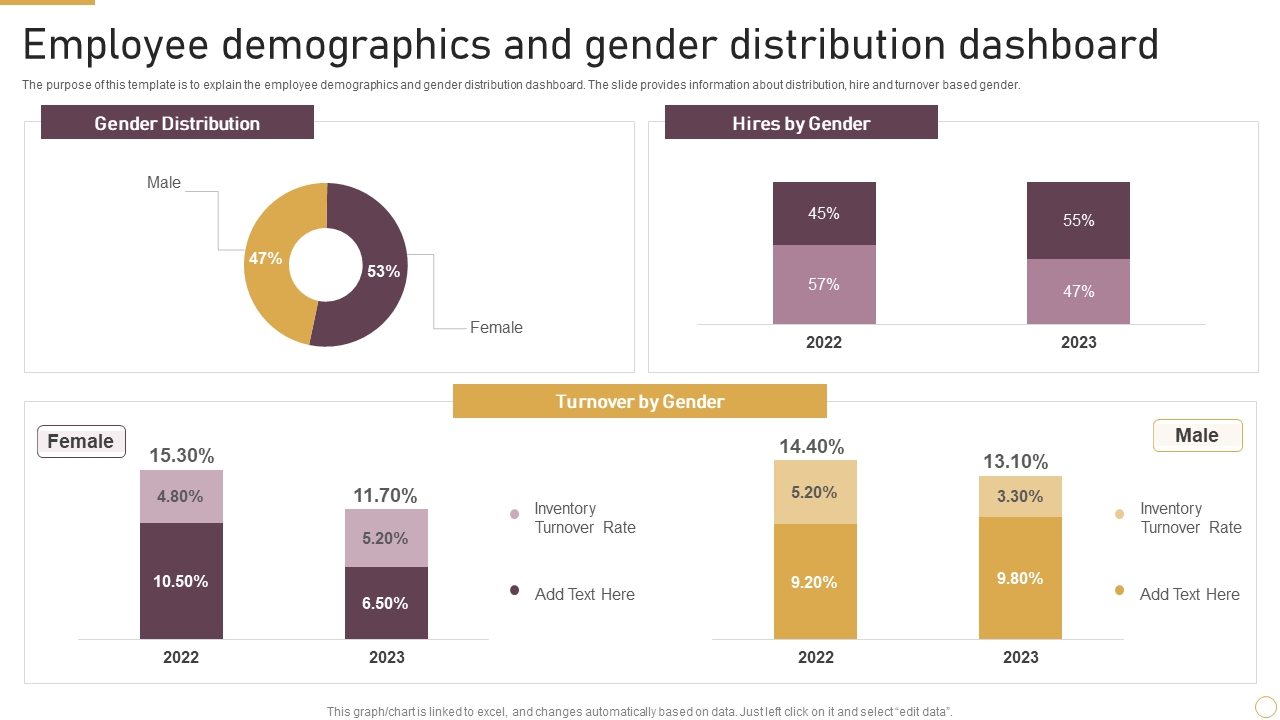

Template 3: Human Resource Diversity Dashboard Based on Demographics PowerPoint Template
This PPT template tracks in- and out-of-office personnel movements and assesses demographic variety inside your company. Your workforce's composition is revealed in this dynamic preset, highlighting opportunities for growth in terms of diversity. Participating in employee insights provides you with knowledge about how your diversity initiatives are affecting your recruiting procedures. On the other hand, information on staff departures aids in locating any problems with diversity retention. With the help of this practical layout, users may enhance inclusion and diversity in their workplaces and guarantee a dynamic and representative workforce. Click below to download!
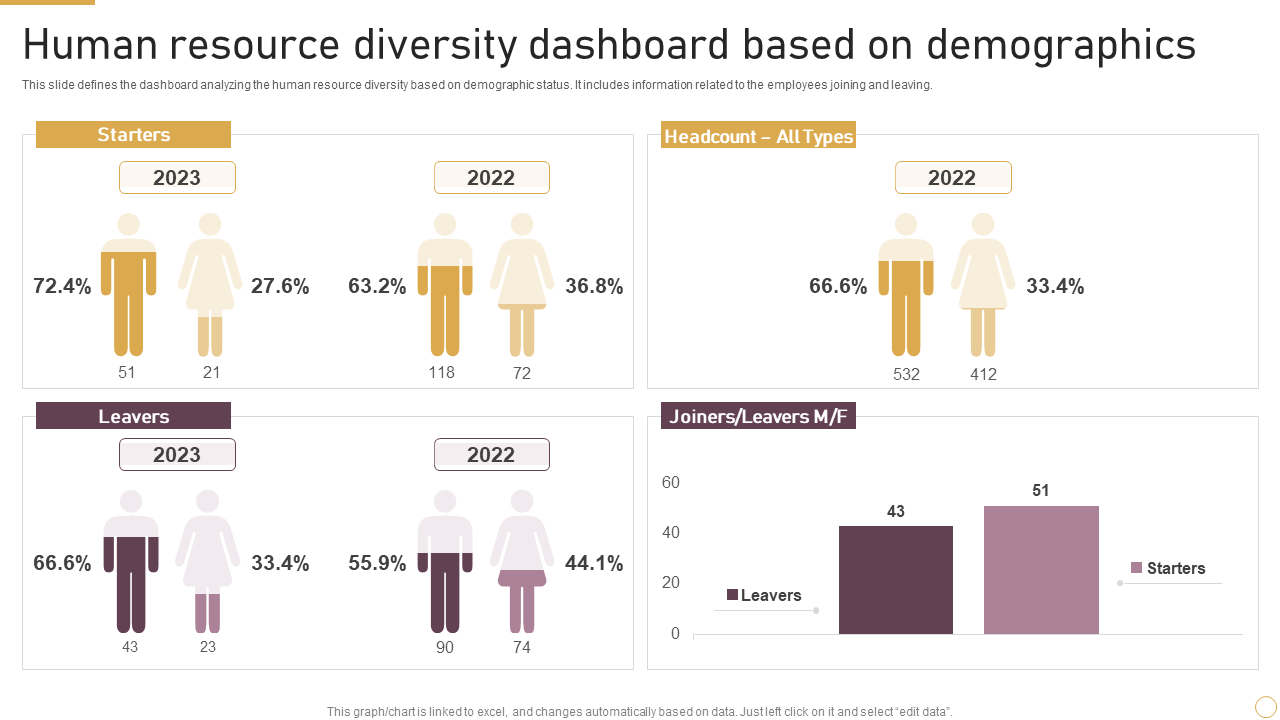
Template 4: Customer persona template capturing demographics goals and buyers’ journey PowerPoint Template
Use this slide as tactical tool for market research and segmentation, as it provides insights into consumer demographics, goals, and travels. This PPT Template helps you develop a thorough persona that facilitates a deeper comprehension of the requirements and phases of your customer's journey, including touchpoints, inquiries, and duties. This dynamic preset makes implementing a customized marketing plan possible, which is crucial to stand out in a competitive market. A unified and prosperous approach is ensured by clearly defining KPIs and responsibilities at every stage of the process, giving users the data they need to win over and keep clients. Get it in a click!
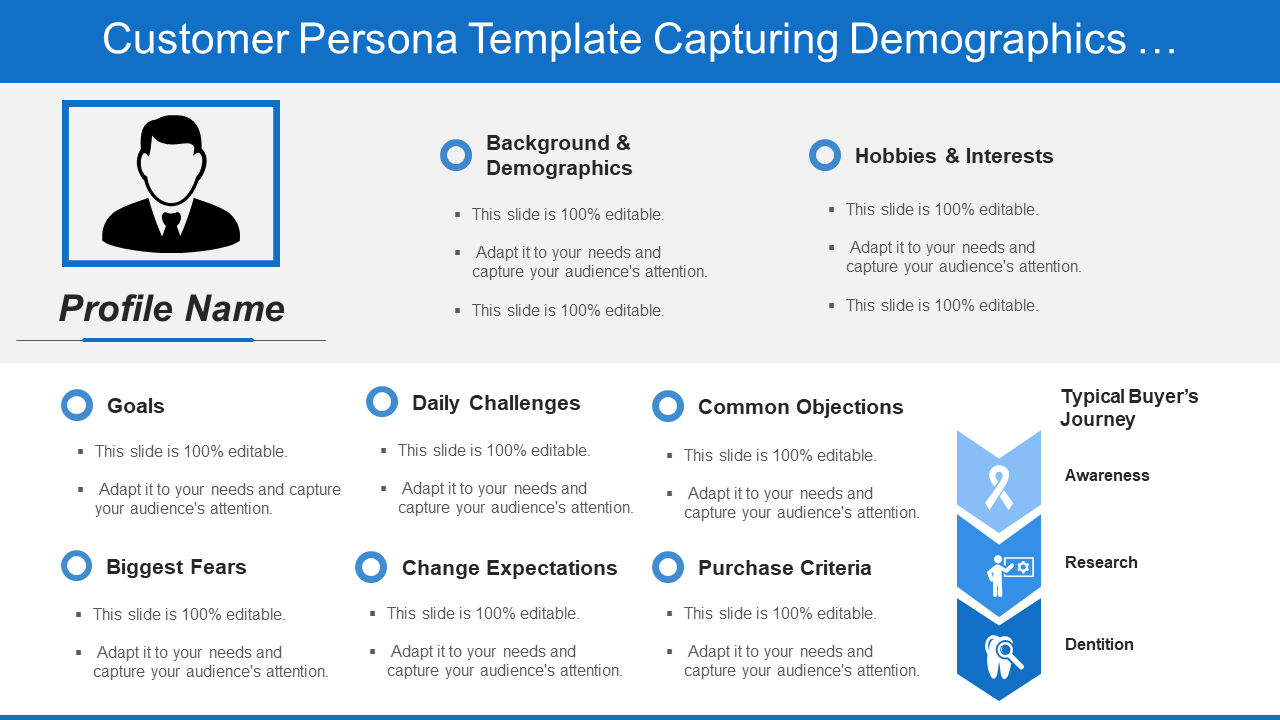
Template 5: Target Market Analysis with Audience Demographics PowerPoint Template
This PPT template is a tool to scrutinize your target audience's demographics. Important demographic characteristics, including gender, age, area, population density, household composition, and income, are included in this template. This effective preset enables more operative marketing strategies by helping customers gain a deeper understanding of their target market. Businesses may tailor their strategy to match the requirements and tastes of a particular community by examining household composition and population density. Similarly, household income data aids in customizing marketing messaging and product offers to target groups' financial situations. This layout benefits businesses looking to enhance their strategic marketing initiatives and fine-tune their market segmentation.
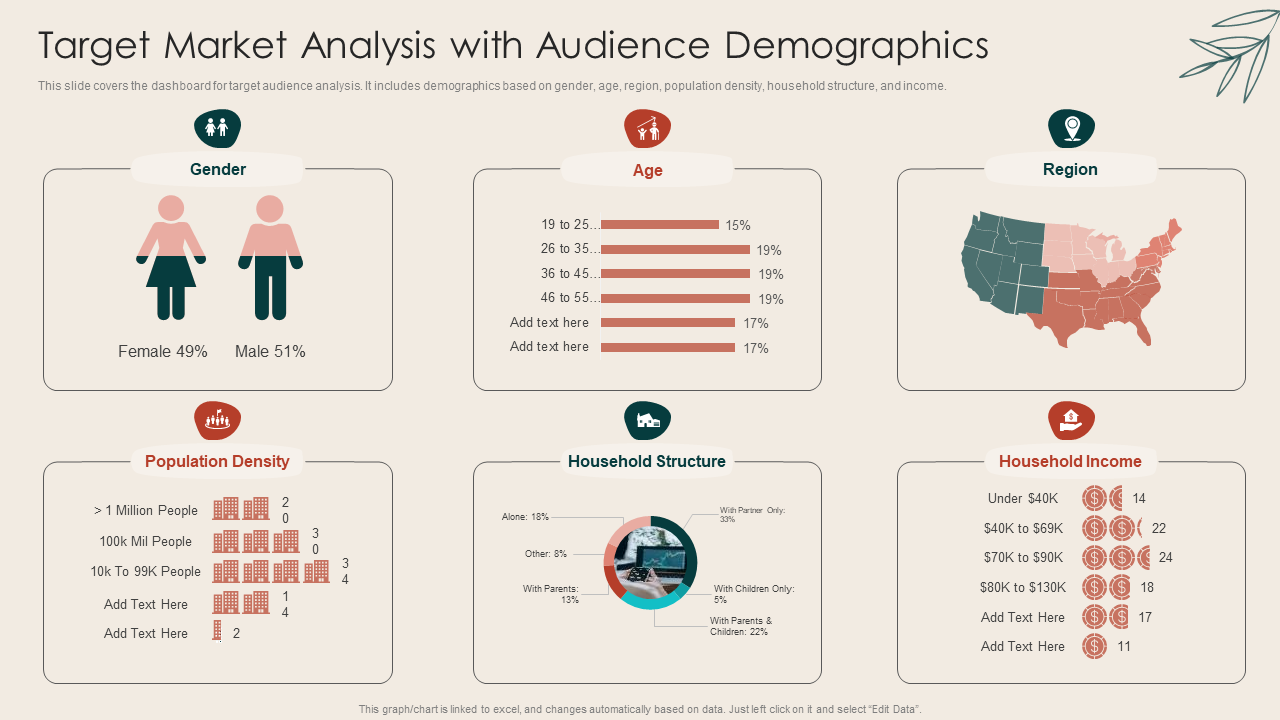
Template 6: Customer Demographic PowerPoint PPT Template Bundles
This PPT Template for customer demographics has been carefully crafted to offer visually appealing backgrounds for a range of subjects, including target audience, market segmentation, customer psychographics, and the usage of consumer profiles. It enables users to communicate ideas persuasively, encouraging audiences to take constructive action. This slide enables users to adapt to a wide range of businesses and sectors, guaranteeing that presentations are customized. Get it now!
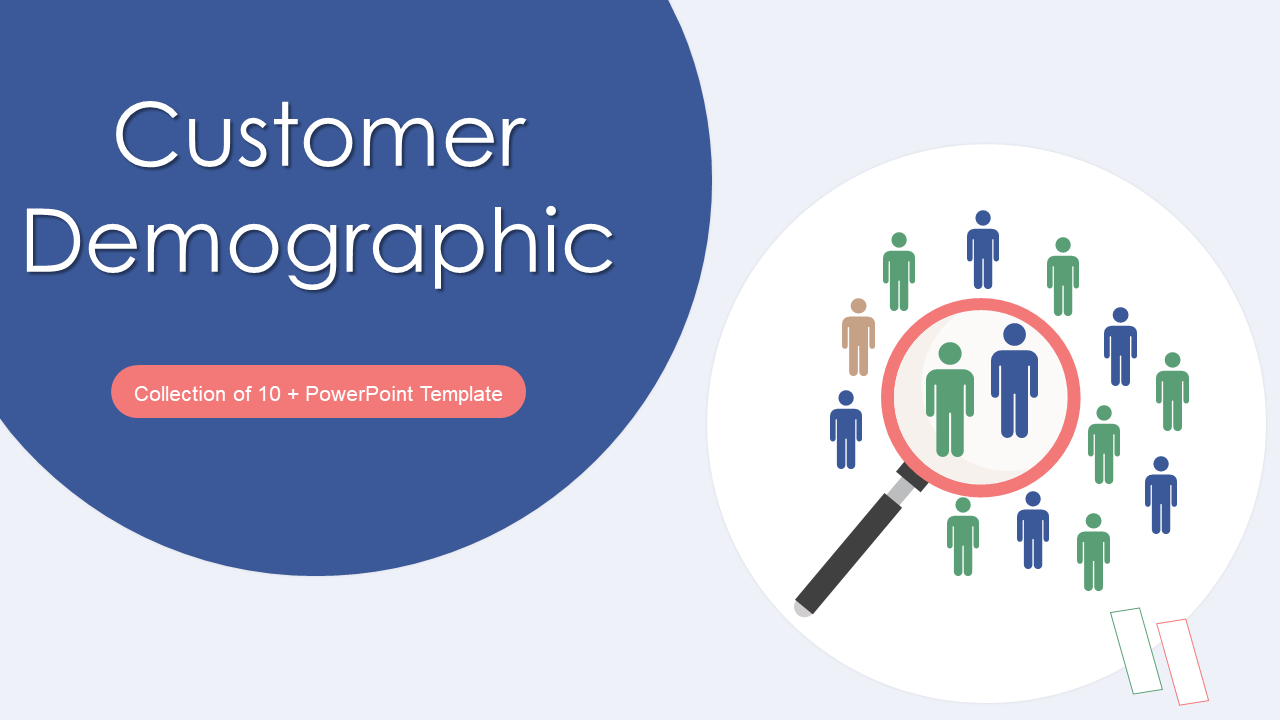
Template 7: Team Demographics PowerPoint PPT Template Bundles
Presenters are guaranteed to be believable and captivating using this PPT Template, with the right visuals and pictures complementing the content. It is an all-inclusive tool for communicating information, such as numbers, data charts, and statistics. Features including gender, ethnicity, job status, and salary-based team demographics enable users to assess and show various elements of their team correctly. This exhibits a dedication to diversity and inclusion while promoting cooperation and understanding among companies. Make it yours now!

Template 8: Target Customer Demographic PowerPoint PPT Template Bundles
This PPT Template collection for the target consumer group offers a classy backdrop for presentations, elevating professionalism. This slide enables users to engage customers and raise brand recognition in a simplified manner. This well-crafted preset’s attractive visuals and substance make communication more accessible and understandable and guarantee that messages are conveyed successfully. You may get a competitive advantage, grab the interest of your audience, and make a lasting impression with distinctive design and aesthetics. This resourceful layout also functions as an instructional tool, allowing users to communicate information on various topics briefly.

Template 9: Account Demographics PowerPoint PPT Template Bundle
Adding sophistication to presentations, this PPT Template elevates professionalism. This template has a fantastic design and enables users to engage the audience with relevant visuals, photos, and structure; it is perfect for professional talks. This influential preset aids users by offering helpful information and account demographics, including gender, parental status, age distribution, and usage behaviours. This adaptable template makes it simple to show account information, from market competition research to user demographics for online learning platforms.

Template 10: Company Demographics PowerPoint PPT Template Bundles
This slide on business demographics offers an elegant backdrop for presentations, elevating their level of professionalism. To create marketing strategies that are both focused and ensure business success, users may take advantage of the business demographics included in this PPT Template. The available technologies make it easier to handle demographic data, which supports strategic scaling activities and well-informed decision-making. The company's performance may be enhanced by using features like employee demographic dashboards and user demographic visualizations, allowing users to monitor audience changes, comprehend service users' demographics, and keep tabs on attrition rates. Click below to download!

Leverage the Potential of Demographic Data
Demographics are the compass in the environment in which company strategy is framed. We encourage you to take advantage of the of data visualization as we draw our exploration on the finest demographic PowerPoint Templates. With these templates, you can navigate the flood of consumer information. Together, let's go on this journey to transform data into actionable steps and illuminate the way to riches in the vast commercial space.
PS Please take advantage of our Top Target Market Templates to unleash the potential of precision marketing and start dominating the industry right now!
Related posts:
- How to Design the Perfect Service Launch Presentation [Custom Launch Deck Included]
- Quarterly Business Review Presentation: All the Essential Slides You Need in Your Deck
- [Updated 2023] How to Design The Perfect Product Launch Presentation [Best Templates Included]
- 99% of the Pitches Fail! Find Out What Makes Any Startup a Success
Liked this blog? Please recommend us

[Updated 2023]: Top 21 Templates to Build a Customer Success Playbook

Top 20 Templates To Build A SaaS Marketing Playbook
This form is protected by reCAPTCHA - the Google Privacy Policy and Terms of Service apply.

Digital revolution powerpoint presentation slides

Sales funnel results presentation layouts
3d men joinning circular jigsaw puzzles ppt graphics icons

Business Strategic Planning Template For Organizations Powerpoint Presentation Slides

Future plan powerpoint template slide

Project Management Team Powerpoint Presentation Slides

Brand marketing powerpoint presentation slides

Launching a new service powerpoint presentation with slides go to market

Agenda powerpoint slide show

Four key metrics donut chart with percentage

Engineering and technology ppt inspiration example introduction continuous process improvement

Meet our team representing in circular format

Here's why Americans having fewer kids won't doom the economy
- America's falling population isn't necessarily bad for the economy, Fisher Investments said.
- The US birth rate just fell to its lowest level in over 40 years, according to provisional CDC data.
- But consequences could be offset by technological advancements and time, the investment firm said.

Americans aren't having nearly as many kids as they used to, but that won't be the blow to the US economy that many have feared, according to Fisher Investments.
In a recent note , the investment advisory firm pointed to falling birthrates around the world, with the US rate falling to a multidecade-low last year. The nation saw the fewest number of babies born since 1979, according to provisional data from the Centers for Disease Control .
That continues a long-running decline in the US birth rate, with the number falling ever since the 1960s, according to World Bank data.
Related stories
But fewer babies being born isn't necessarily a bad thing for the economy, the firm said. The birth rate has fallen before without crimping growth, such as during the '80s and '90s, when the economy boomed despite falling fertility the prior decade.
A falling birthrate is also more typical among wealthier nations. That's because the nation has a lower infant mortality rate and people are generally living longer, allowing them to have fewer babies and potentially postpone having kids.
"Yes, falling birth rates could have negative long-run ramifications if a true reduction in human capital and other factors don't offset this. But that isn't a given since a lot can change in the near and distant future," the firm added.
Economists have said technological advances, like AI, could blunt the impact of a smaller workforce. AI could disrupt as many as 300 million jobs around the world, Goldman Sachs estimated. That could mean the economy will be just fine, even with a smaller number of people entering the workforce.
Even if falling birthrates do weigh on the economy , it won't affect the market right away. The burden of a falling population takes years to reveal its full effect, meaning the market and the economy aren't in any near-term peril, Fisher added.
"Concerns about fewer babies are rooted in the notion population growth is tied to economic growth (i.e., any slowdown or decline in the former will hurt the latter,) the firm said. "To us, this says more about where sentiment is today: when well-known false fears grab eyeballs, skepticism remains pretty prevalent, suggesting the wall of worry bull markets climb remains high."
Ken Fisher, the firm's founder and co-chief investment officer, has been bullish on stocks for months, brushing off the market's fears over a potential recession and higher-for-longer interest rates. Stocks are likely still in a bull market , he said, as bear markets typically begin with a gradual decline in equities, not a sudden drop, which stocks saw over the past month.
Watch: Why childcare has become so unaffordable
- Main content
NIOSH Science Blog: The Problem of Falls from Elevation in Construction and Prevention Resources
The current situation with falls.
In 2022 falls from elevation represented approximately 81% of all fatal and 20% of all nonfatal slips, trips, and falls for all industry workers (BLS 2023a, BLS 2023b). Many of these falls occurred in the construction industry, and significantly impact construction employers, workers, and their families. In fact, construction workers made up nearly half (49%) of all fatal occupational slips, trips, and falls (BLS 2023). Since 2013, construction workers have suffered approximately 300 fatal and 20,000 nonfatal fall-related injuries per year (CPWR 2024). Four out of 10 of the Occupational Safety and Health Administration’s (OSHA) top citations involved falls, including general fall protection, ladders, scaffolding, and fall protection training.
Roofing contractors, residential building construction, and commercial/institutional building construction had the highest number of fatalities in 2022 compared to previous years and other industries (CPWR 2024). In addition, approximately 70% of all fatal falls in construction occurred to those working for employers with less than 10 employees (CPWR 2024).
Causes of Falls
The causes of construction workers’ falls from elevation are complex and multifaceted. There are many different factors at play. In 2021, CPWR conducted a fall experience survey that found that insufficient or ineffective planning is a key underlying cause of falls.
In addition, lack of planning was associated with reduced likelihood of using fall protection. Using fall protection was 71% lower for workers whose employer did not do any planning. Approximately half (49%) of survey respondents said that no fall protection was being used at the time of the fall. Lack of fall protection is particularly problematic for small residential construction firms with fewer than 10 employees (CPWR 2022).
Ladders and Ladder Safety
Falls from ladders are a common cause of injury for construction workers (CPWR 2024). Employers should be familiar with safety and regulatory requirements before using a ladder, including:
Planning work tasks to eliminate or reduce the need to work at elevation.
Providing the right equipment. This includes alternative equipment for extended work periods at elevation, such as aerial lifts, supported scaffolds, or mast climbing platforms. If a ladder must be used, properly select the ladder for the location and height of the task and the weight of the worker. Ensure it is thoroughly inspected before each use.
Training all workers in a language they understand on the proper use, care, and inspection of each type of ladder being used.
A recent webinar hosted by CPWR – The Center for Construction Research and Training (CPWR) discussed ladder safety and ways to improve ladder design, usage, and training. The webinar included a panel of experts who conduct laboratory research on ways to prevent common ladder fall injuries, such as slipping off a ladder and falling with the ladder. The audio from the webinar is also available in Spanish .
Ladder Safety Resources
Ladder Safety App
National Ladder Safety Month website
ALI Training
ANSI blog on 5 most common causes of ladder incidents based on ALI study
OSHA Stairways and Ladders
OSHA Letter of Interpretation on three points of contact
Rescue Planning
Falls can occur quickly, even when all precautions are taken and using proper fall prevention and protection methods. Personal Fall Arrest Systems are a critical option to keep workers safe when performing tasks at heights, but rescue planning is essential.
If a fall occurs and a worker is suspended in a harness for more than a few minutes, a lack of circulation can cause unconsciousness, suspension trauma, and even death.
Every fall protection plan must include a rescue strategy to help workers after a fall and reduce fall-related injuries including suspension trauma even when using a Personal Fall Arrest System. Another finding from CPWR’s fall experience survey was that the odds of a fall being fatal were 76% lower for those who had self-rescue training compared to those who did not have this training. The rescue plan should be tailored to each jobsite and prioritize methods to preserve blood circulation for the worker. Ensure equipment for self-rescue is available, such as trauma straps and self-rescue harness units. The rescue plan should ensure other equipment is available, ready to be used, and in good condition, such as a ladder, aerial lift, or bucket truck.
Rescue Planning Resources
CPWR General Fall Protection Plan (English)
CPWR General Fall Protection Plan (Spanish)
OSHA Model Fall Protection Plan
OSHA Standard Interpretations – Rescue of a suspended worker following a fall event
CPWR Fall Rescue Planning Tipsheet
CPWR Fall Rescue Planning Tipsheet (Spanish)
The National Safety Stand-Down to Prevent Falls in Construction
The National Campaign to Prevent Falls in Construction (Falls Campaign) began in 2012 and was followed in 2014 by the National Safety Stand-Down to Prevent Falls in Construction (Stand-Down). The Falls Campaign idea originated with the National Occupational Research Agenda (NORA) Construction Sector Council. The Sector Council consists of industry experts on health and safety representing contractors, trade associations, labor, government, and academia. The National Institute for Occupational Safety and Health (NIOSH), OSHA, and CPWR are the Falls Campaign organizing partners. The Falls Campaign and Stand-Down are important events because of the high burden falls place on construction workers and their families.
Safety stand-downs originated in the military and are a time to focus on worker safety by stopping work and reinforcing the importance of fall prevention and fall protection.
This year’s Stand-Down will take place May 6-10, 2024. CPWR, NIOSH, and OSHA are hosting a virtual event on Tuesday May 7 th at 2 pm (Eastern Time) to educate employers and crew leaders on how rescue planning can save lives. Click here to register and submit a question in advance. Attendees will learn more about identifying a competent person to lead fall prevention and rescue planning, incorporating key components of a rescue plan into the pre-job planning process, and using FREE resources and templates to tailor your plans to each unique jobsite. The webinar will be in English with simultaneous translation into Spanish available.
On May 8 th at 2pm (Eastern Time) a second Stand-Down webinar presented entirely in Spanish will be hosted. Click here to register and submit a question in advance.
Hosting a Stand-Down
Thousands of companies have held fall safety stand-downs , reaching millions of workers across all 50 states and internationally. Industry and business leaders, universities, labor organizations, and community groups have all participated. In 2023, there were 3,554 stand-downs reaching more than 463,000 workers.
Construction employers and workers are invited to host a Safety Stand-Down or join one.
Your involvement can be as simple as sharing NIOSH, OSHA, or CPWR resources at your worksite. If you would like to host or join a free event that is open to the public, contact your Regional Stand-Down Coordinator . You can find resources to host a Stand-Down and activities at CPWR’s Promotion and Planning Page .
If you do participate in the Stand-Down, make sure you get a Certificate of Participation from OSHA. The certificates provide recognition for your event(s). After removing all personal information, CPWR used the data to evaluate and improve the Falls Campaign and Stand-Down every year. Previous evaluation reports and factsheets can be found on the Stop Construction Falls Evaluation page .
Stand-down Resources
About the Campaign
CPWR’S Planning and Promotion Page on StopConstructionFalls.com
Suggestions to prepare successful Stand-Downs
Highlights from previous Stand-Downs
OSHA Regional Stand-Down Coordinators
OSHA Certificates of Participation
Additional Tools and Resources
National Falls Campaign & Safety Stand-Down Website
CPWR Data Bulletin
Bilingual Fall Hazards & Prevention YouTube Playlist
Spanish Fall Safety YouTube Playlist (Prevención de caídas)
Christina Socias-Morales, DrPH is a Research Epidemiologist in the NIOSH Office of Construction Safety and Health.
Scott Earnest, PhD, PE, CSP, is the Associate Director for the NIOSH Office of Construction Safety and Health.
Jessica Bunting, MPH, is the Research to Practice Director at the Center for Construction Research and Training (CPWR).
Rosa Greenberg, MPH, is a Research Analyst in Research to Practice at CPWR
Scott Breloff, Ph.D. is a Senior Biomechanical Research Engineer in the Division of Field Studies & Engineering and the Co-Coordinator for the Construction Program in the Office of Construction Safety and Health at NIOSH.
Asha Brogan, MS, is a Heath Communication Fellow in the NIOSH Division of Field Studies & Engineering.
Douglas Trout, MD, MHS, is Deputy Director, Office of Construction Safety and Health at NIOSH.
Bureau of Labor Statistics (2023a). News Release National Census of Fatal Occupational Injuries in 2022. USDL-23-2615. December 19, 2023. Available from: https://www.bls.gov/news.release/pdf/cfoi.pdf .
Bureau of Labor Statistics (2023b). Number of nonfatal occupational injuries and illnesses involving days away from work, restricted activity, or job transfer (DART), days away from work (DAFW), and days of restricted work activity, or job transfer (DJTR) by event or exposure leading to injury or illness and industry sector, private industry, 2021-2022 (TABLE R64). November 8, 2023. Available from: https://www.bls.gov/iif/nonfatal-injuries-and-illnesses-tables/case-and-demographic-characteristics-table-r64-2021-2022.xlsx
CPWR (2024). Data Bulletin: Fatal and Nonfatal Falls in the US Construction Industry. The Center for Construction Research and Training. Silver Spring, MD. March 2024. https://www.cpwr.com/wp-content/uploads/DataBulletin-March2024.pdf.
CPWR (2022). Underlying Causes of Falls from Heights (Highlighted Findings from a CPWR Survey). The Center for Construction Research and Training. Silver Spring, MD. March 2022. https://www.cpwr.com/wp-content/uploads/RR-falls_experience_survey.pdf.
Post a Comment
Cancel reply.
Your email address will not be published. Required fields are marked *
- 50th Anniversary Blog Series
- Additive Manufacturing
- Aging Workers
- Agriculture
- Animal/Livestock hazards
- Artificial Intelligence
- Back Injury
- Bloodborne pathogens
- Cardiovascular Disease
- cold stress
- commercial fishing
- Communication
- Construction
- Cross Cultural Communication
- Dermal Exposure
- Education and Research Centers
- Electrical Safety
- Emergency Response/Public Sector
- Engineering Control
- Environment/Green Jobs
- Epidemiology
- Fire Fighting
- Food Service
- Future of Work and OSH
- Healthy Work Design
- Hearing Loss
- Heat Stress
- Holiday Themes
- Hydraulic Fracturing
- Infectious Disease Resources
- International
- Landscaping
- Law Enforcement
- Manufacturing
- Manufacturing Mondays Series
- Mental Health
- Motor Vehicle Safety
- Musculoskeletal Disorders
- Nanotechnology
- National Occupational Research Agenda
- Needlestick Prevention
- NIOSH-funded Research
- Nonstandard Work Arrangements
- Observances
- Occupational Health Equity
- Oil and Gas
- Outdoor Work
- Partnership
- Personal Protective Equipment
- Physical activity
- Policy and Programs
- Prevention Through Design
- Prioritizing Research
- Reproductive Health
- Research to practice r2p
- Researcher Spotlights
- Respirators
- Respiratory Health
- Risk Assessment
- Safety and Health Data
- Service Sector
- Small Business
- Social Determinants of Health
- Spanish translations
- Sports and Entertainment
- Strategic Foresight
- Struck-by injuries
- Student Training
- Substance Use Disorder
- Surveillance
- Synthetic Biology
- Systematic review
- Take Home Exposures
- Teachers/School Workers
- Temporary/Contingent Workers
- Total Worker Health
- Translations (other than Spanish)
- Transportation
- Uncategorized
- Veterinarians
- Wearable Technologies
- Wholesale and Retail Trade
- Work Schedules
- Workers' Compensation
- Workplace Medical Mystery
- Workplace Supported Recovery
- World Trade Center Health Program
- Young Workers
To receive email updates about this page, enter your email address:
Exit Notification / Disclaimer Policy
- The Centers for Disease Control and Prevention (CDC) cannot attest to the accuracy of a non-federal website.
- Linking to a non-federal website does not constitute an endorsement by CDC or any of its employees of the sponsors or the information and products presented on the website.
- You will be subject to the destination website's privacy policy when you follow the link.
- CDC is not responsible for Section 508 compliance (accessibility) on other federal or private website.
Biden administration plans to reclassify marijuana, easing restrictions nationwide
WASHINGTON — The Biden administration will take a historic step toward easing federal restrictions on cannabis, with plans to announce an interim rule soon reclassifying the drug for the first time since the Controlled Substances Act was enacted more than 50 years ago, four sources with knowledge of the decision said.
The Drug Enforcement Administration is expected to approve an opinion by the Department of Health and Human Services that marijuana should be reclassified from the strictest Schedule I to the less stringent Schedule III. It would be the first time that the U.S. government has acknowledged its potential medical benefits and begun studying them in earnest.
Attorney General Merrick Garland submitted the rescheduling proposal to the White House Office of Management and Budget on Tuesday afternoon, a source familiar with the situation confirmed.
Any reclassification is still months from going into effect. After the proposal is published in the Federal Register, there will be a 60-day public comment period. The proposal will then be reviewed by an administrative law judge, who could decide to hold a hearing before the rule is approved.
What rescheduling means
Since 1971, marijuana has been in the same category as heroin, methamphetamines and LSD. Each substance under the Schedule I classification is defined as a drug with no accepted medical use and a high potential for abuse. Schedule III substances include Tylenol with codeine, steroids and testosterone.
By rescheduling cannabis, the drug would be studied and researched to identify concrete medical benefits, opening the door for pharmaceutical companies to get involved with the sale and distribution of medical marijuana in states where it is legal.

For the $34 billion cannabis industry, the move would also eliminate significant tax burdens for businesses in states where the drug is legal, notably getting rid of the IRS' code Section 280E, which prohibits legal cannabis companies from deducting what would otherwise be ordinary business expenses.
The Justice Department’s rescheduling decision could also help shrink the black market, which has thrived despite legalization in states like New York and California and has undercut legal markets, which are fiercely regulated and highly taxed.
Years in the making
President Joe Biden directed the Department of Health and Human Services in October 2022 to review marijuana’s classification. Federal scientists concluded that there is credible evidence that cannabis provides medical benefits and that it poses lower health risks than other controlled substances.
Biden even made history in his State of the Union address this year, for the first time referring to marijuana from the dais in the House chamber and making note of the federal review process. “No one should be jailed for using or possessing marijuana,” he said.
When Biden was vice president in the Obama administration, the White House opposed any legalization of marijuana, saying it would “pose significant health and safety risks to all Americans.”
Jim Cole, who was deputy attorney general in the Obama administration, wrote the famous Cole Memo in 2013 , paving the way for the modern marijuana market. The memo scaled back federal intervention in states that had legalized marijuana as long as they implemented “strong and effective regulatory and enforcement systems to control the cultivation, distribution, sale and possession of marijuana.”
Cole, who is now a member of the National Cannabis Roundtable, said in an interview this week that reclassifying marijuana to Schedule III would “open up the ability to actually test it and put it in a laboratory without all of the restrictive measures” of a Schedule I drug.
Kevin Sabet, president and CEO of Smart Approaches to Marijuana and a former Obama administration adviser, said the decision to reclassify marijuana is "the result of a politicized process," arguing that it "will be devastating for America’s kids, who will be bombarded with attractive advertising and promotion of kid-friendly pot products."
"The only winner here is the marijuana industry, who will receive a new tax break and thus widen their profit margins," Sabet said. “Reclassifying marijuana as a Schedule III drug sends the message that marijuana is less addictive and dangerous now than ever before. In reality, today’s highly potent, super strength marijuana is more addictive and linked with psychosis and other mental illnesses, IQ loss and other problems.”
Researchers have raised concerns about high-potency marijuana and cannabis-induced psychiatric disorders, particularly among young men.
Some challenges ahead
Once the DEA formally makes its announcement, the marijuana industry would see an immediate benefit. But with the DEA’s proposed rule change comes a public review period that could lead to a challenge, and perhaps even a change, to the rescheduling proposal.
Once the public comment period has concluded and the Office of Management and Budget reviews the decision, Congress would also be able to overturn the rule under the Congressional Review Act, which gives it the power to weigh in on rules issued by federal agencies. Democrats control the Senate with a 51-seat majority, and for an overturn under the CRA to succeed, two-thirds of the House and the Senate would be needed to support it, meaning the marijuana rescheduling would most likely survive.
Though cannabis remains a divisive topic on Capitol Hill, there has been growing support on a bipartisan basis for marijuana reforms, largely driven by the electorate. Nearly 6 in 10 Americans say marijuana should be legal for medical and recreational purposes, according to a Pew Research poll last month. Cannabis is legal in 24 states for recreational use.
Congress is considering its own bills
Congress is considering its own measures that would make it easier for legal marijuana businesses to thrive and allow for more small and minority-owned shops to flood the marketplace.
The SAFER Banking Act , for example, which would grant legal marijuana businesses access to traditional banking and financial services, could pass both chambers by the end of the year.
Lawmakers are also considering the HOPE Act , another bipartisan bill that would provide states and local governments with resources to automatically expunge criminal records for petty, nonviolent cannabis offenses.
There is also a Democratic-only effort to remove cannabis entirely from the Controlled Substances Act, empowering states to create their own cannabis laws and prioritize restorative and economic justice for those affected by the “war on drugs.”
Senate Majority Leader Chuck Schumer, D-N.Y., praised the administration for its move, saying it amounts to "finally recognizing that restrictive and draconian cannabis laws need to change to catch up to what science and the majority of Americans have said loud and clear."
At the same time, he said he is "strongly committed" to moving forward with both the SAFER Banking Act and the Democratic bill to remove cannabis from the Controlled Substances Act entirely. “Congress must do everything we can to end the federal prohibition on cannabis and address longstanding harms caused by the War on Drugs," he said in a statement.
Sen. Cory Booker, D-N.J., also praised the administration’s move but cautioned that “we still have a long way to go.”
Booker called on Congress in a statement to "follow the lead of states around the country and legalize cannabis for adult-use and create a comprehensive taxation and regulatory scheme."
“Thousands of people remain in prisons around the country for marijuana-related crimes. Thousands of people continue to bear the devastating collateral consequences that come with a criminal record,” he said. “Legal marijuana businesses, especially those in communities hardest hit by the War on Drugs, still have to navigate a convoluted patchwork of state laws and regulatory schemes. I hope that my colleagues on both sides of the aisle, especially those who represent constituents benefitting from medical or adult-use programs, join me to pass federal legislation to fix these problems.”
But there is weariness among lawmakers who remember the last time Congress made law surrounding the drug.
The Republican-led Senate legalized hemp production in the 2018 farm bill, a decision that led to synthetic and exotic cannabinoids’ being sold over the counter, often without regulation, particularly in states where marijuana isn’t legal.
It’s a gray area that has drawn pushback from both sides of the aisle, most recently with the rise of Delta-8 , a synthetic tetrahydrocannabinol product that uses chemicals — some of them harmful — to convert hemp-derived CBD into Delta-8 THC.
Julie Tsirkin is a correspondent covering Capitol Hill.
Monica Alba is a White House correspondent for NBC News.
Fact Check Team: New report finds Social Security is set to run dry by 2035
by KONNER MCINTIRE | The National Desk

WASHINGTON (TND) — Nearly 68 million Americans monthly are expected to receive a Social Security benefit, amounting to about $1.5 trillion in benefits paid during the year. The latest annual report from the Social Security Board of Trustees indicates that Social Security continues to grapple with "significant financing issues," and is on course to be insolvent by 2035.
Since 2010, Social Security has been operating at a deficit, spending more money than it brings in. This trend has exacerbated the strain on the program's financial reserves.
If Social Security were to run out of funds by 2035, beneficiaries could face cuts to their benefits. The prediction for insolvency is a year later than the report’s forecast last year. According to the agency’s estimates, individuals could experience a 17% reduction in their current benefits. While this scenario would undoubtedly have a profound impact on millions of Americans, it represents a slight improvement from previous projections, which suggested a 23% cut in benefits.
The roots of Social Security's financial instability trace back to 2010 when the program began operating at a deficit for the first time since 1983 , spending more than it earns. This trend has been exacerbated by the aging population and the retirements of the baby boomer generation. A fact sheet from the Social Security Administration reports in 1940, the life expectancy of a 65-year-old was almost 14 years, but today it is over 20 years. The fact sheet also reports the number of Americans aged 65 and older is expected to surge from about 58 million in 2022 to about 75 million by 2035.
To avert this looming crisis, action from Congress is essential. Tough reforms, such as potential increases in taxes or cuts to benefits, are being considered to shore up Social Security's finances and ensure its long-term sustainability. Republicans have also proposed raising the retirement age to 67.
These measures are reminiscent of the last major Social Security reforms that were enacted under President Ronald Reagan in 1983 when Social Security insolvency was just months away . Under those amendments , Congress raised the retirement age, delayed cost-of-living adjustments to benefits, extended coverage to new federal employees and nonprofit employees, and increased taxes to stave off insolvency.
- Skip to main content
- Skip to FDA Search
- Skip to in this section menu
- Skip to footer links

The .gov means it’s official. Federal government websites often end in .gov or .mil. Before sharing sensitive information, make sure you're on a federal government site.
The site is secure. The https:// ensures that you are connecting to the official website and that any information you provide is encrypted and transmitted securely.
U.S. Food and Drug Administration
- Search
- Menu
- Advisory Committees
- Advisory Committee Calendar
- June 4, 2024: Meeting of the Psychopharmacologic Drugs Advisory Committee Meeting Announcement - 06/04/2024
Advisory Committee Meeting | Mixed
Event Title June 4, 2024: Meeting of the Psychopharmacologic Drugs Advisory Committee Meeting Announcement June 4, 2024
What is an advisory committee.
Advisory committees provide independent expert advice to the FDA on broad scientific topics or on certain products to help the agency make sound decisions based on the available science. Advisory committees make non-binding recommendations to the FDA, which generally follows the recommendations but is not legally bound to do so. Please see, " Advisory Committees Give FDA Critical Advice and the Public a Voice ," for more information.
Center: Center for Drug Evaluation and Research
Location: FDA and invited participants may attend the meeting at FDA White Oak Campus, 10903 New Hampshire Ave., Bldg. 31 Conference Center, the Great Room (Rm. 1503), Silver Spring, MD 20993-0002. The public will have the option to participate via an online teleconferencing and/or video conferencing platform, and the advisory committee meeting will be heard, viewed, captioned, and recorded through an online teleconferencing and/or video conferencing platform.
The meeting presentations will be heard, viewed, captioned, and recorded through an online teleconferencing and/or video conferencing platform. The Committee will discuss new drug application 215455, for midomafetamine (MDMA) capsules, submitted by Lykos Therapeutics, for the proposed indication of treatment of post-traumatic stress disorder. The Committee will be asked to discuss the overall benefit-risk profile of the product, including the potential public health impact.
Meeting Materials
FDA intends to make background material and the link to the live webcast available to the public no later than two (2) business days before the meeting in the Event Materials section of this web page. If FDA is unable to post the background material on its website prior to the meeting, the background material will be made publicly available on FDA’s website at the time of the advisory committee meeting. The meeting will include slide presentations with audio and video components to allow the presentation of materials for online participants in a manner that most closely resembles an in-person advisory committee meeting.
Public Participation Information
Interested persons may present data, information, or views, orally or in writing, on issues pending before the committee.
FDA is establishing a docket for public comment on this meeting. The docket number is FDA-2024-N-1938 . Please note that late, untimely filed comments will not be considered. The docket will close on June 3, 2024. The https://www.regulations.gov electronic filing system will accept comments until 11:59 p.m. Eastern Time at the end of June 3, 2024. Comments received by mail/hand delivery/courier (for written/paper submissions) will be considered timely if they are received on or before that date.
Comments received on or before May 23, 2024 will be provided to the Committee. Comments received after that date will be taken into consideration by FDA. In the event that the meeting is cancelled, FDA will continue to evaluate any relevant applications or information, and consider any comments submitted to the docket, as appropriate. You may submit comments as follows:
Electronic Submissions
Submit electronic comments in the following way:
- Federal eRulemaking Portal: https://www.regulations.gov . Follow the instructions for submitting comments. Comments submitted electronically, including attachments, to https://www.regulations.gov will be posted to the docket unchanged. Because your comment will be made public, you are solely responsible for ensuring that your comment does not include any confidential information that you or a third party may not wish to be posted, such as medical information, your or anyone else’s Social Security number, or confidential business information, such as a manufacturing process. Please note that if you include your name, contact information, or other information that identifies you in the body of your comments, that information will be posted on https://www.regulations.gov .
- If you want to submit a comment with confidential information that you do not wish to be made available to the public, submit the comment as a written/paper submission and in the manner detailed (see “Written/Paper Submissions” and “Instructions”).
Written/Paper Submissions
Submit written/paper submissions as follows:
- Mail/Hand delivery/Courier (for written/paper submissions): Dockets Management Staff (HFA-305), Food and Drug Administration, 5630 Fishers Lane, Rm. 1061, Rockville, MD 20852.
- For written/paper comments submitted to the Dockets Management Staff, FDA will post your comment, as well as any attachments, except for information submitted, marked and identified, as confidential, if submitted as detailed in “Instructions.”
Instructions: All submissions received must include the Docket No. FDA-2024-N-1938 for “Psychopharmacologic Drugs Advisory Committee; Notice of Meeting; Establishment of a Public Docket; Request for Comments-- midomafetamine (MDMA) capsules.” Received comments, those filed in a timely manner, will be placed in the docket and, except for those submitted as “Confidential Submissions,” publicly viewable at https://www.regulations.gov or at the Dockets Management Staff between 9 a.m. and 4 p.m., Monday through Friday, 240-402-7500.
- Confidential Submissions--To submit a comment with confidential information that you do not wish to be made publicly available, submit your comments only as a written/paper submission. You should submit two copies total. One copy will include the information you claim to be confidential with a heading or cover note that states “THIS DOCUMENT CONTAINS CONFIDENTIAL INFORMATION.” FDA will review this copy, including the claimed confidential information, in its consideration of comments. The second copy, which will have the claimed confidential information redacted/blacked out, will be available for public viewing and posted on https://www.regulations.gov . Submit both copies to the Dockets Management Staff. If you do not wish your name and contact information be made publicly available, you can provide this information on the cover sheet and not in the body of your comments and you must identify the information as “confidential.” Any information marked as “confidential” will not be disclosed except in accordance with 21 CFR 10.20 and other applicable disclosure law. For more information about FDA’s posting of comments to public dockets, see 80 FR 56469, September 18, 2015, or access the information at: https://www.gpo.gov/fdsys/pkg/FR-2015-09-18/pdf/2015-23389.pdf .
Docket: For access to the docket to read background documents or the electronic and written/paper comments received, go to https://www.regulations.gov and insert the docket number, found in brackets in the heading of this document, into the “Search” box and follow the prompts and/or go to the Dockets Management Staff, 5630 Fishers Lane, Rm. 1061, Rockville, MD 20852, 240-402-7500.
Oral Presentations
Oral presentations from the public will be scheduled between approximately 2 p.m. and 3.p.m Eastern Time and will take place entirely through an online meeting platform. Those individuals interested in making formal oral presentations should notify the contact person and submit a brief statement of the general nature of the evidence or arguments they wish to present, the names and addresses of proposed participants, and an indication of the approximate time requested to make their presentation on or before May 17, 2024.
Time allotted for each presentation may be limited. If the number of registrants requesting to speak is greater than can be reasonably accommodated during the scheduled open public hearing session, FDA may conduct a lottery to determine the speakers for the scheduled open public hearing session. The contact person will notify interested persons regarding their request to speak by May 20, 2024.
Webcast Information
CDER plans to provide a free of charge, live webcast of the upcoming advisory committee meeting. If there are instances where the webcast transmission is not successful, staff will work to re-establish the transmission as soon as possible. Further information regarding the webcast, including the web address for the webcast, will be made available no later than two (2) business days before the meeting in the Event Materials section of this web page.
CDER plans to post archived webcasts after the meeting, however, in cases where transmission was not successful, archived webcasts will not be available.
Contact Information
- Joyce Frimpong, PharmD Center for Drug Evaluation and Research Food and Drug Administration 10903 New Hampshire Avenue WO31-2417 Silver Spring, MD 20993-0002 Phone: 240-762-8729 Email: [email protected]
- FDA Advisory Committee Information Line 1-800-741-8138 (301-443-0572 in the Washington DC area) Please call the Information Line for up-to-date information on this meeting.
- For press inquiries, please contact the Office of Media Affairs at [email protected] or 301–796–4540.
A notice in the Federal Register about last minute modifications that impact a previously announced advisory committee meeting cannot always be published quickly enough to provide timely notice. Therefore, you should always check the agency’s website or call the committee’s Designated Federal Officer (see Contact Information) to learn about possible modifications before coming to the meeting.
Persons attending FDA’s advisory committee meetings are advised that the agency is not responsible for providing access to electrical outlets. FDA welcomes the attendance of the public at its advisory committee meetings and will make every effort to accommodate persons with disabilities. If you require accommodations due to a disability, please contact the committee’s Designated Federal Officer (see Contact Information) at least 7 days in advance of the meeting.
Answers to commonly asked questions including information regarding special accommodations due to a disability may be accessed at: Common Questions and Answers about FDA Advisory Committee Meetings .
FDA is committed to the orderly conduct of its advisory committee meetings. Please visit our Web site at Public Conduct During FDA Advisory Committee Meetings for procedures on public conduct during advisory committee meetings.
Notice of this meeting is given under the Federal Advisory Committee Act (5 U.S.C. app.2).

IMAGES
VIDEO
COMMENTS
USAFacts used the final intercensal estimates for 1970 through 2009 and the provisional postcensal estimates for 2010 and after. The most recent county-level data available by age, race, sex, and ethnicity are the Vintage 2020 Population Estimates (census.gov) for 2010 to 2019 and the Vintage 2022 Population Estimates (census.gov) for 2020 ...
In 2020, the Hispanic or Latino population became the largest racial or ethnic group in California, comprising 39.4% of the total population, up from 37.6% in 2010. This differs from 2010, when the largest racial or ethnic group in California was the White alone non-Hispanic population, whose share declined from 40.1% in 2010 to 34.7% in 2020.
The 2020 Demographic Analysis estimates include national-level estimates of the population by age, sex, race and Hispanic origin as of April 1, 2020. These estimates are developed from current and historical vital statistics - birth and death records, estimates of international migration, and Medicare records. The Demographic Analysis ...
United States Demographics - Statistics & Facts. United States. With a population of more than 330 million people, the United States is the third most populous country in the world. The U.S. is ...
As a supplement to the America Counts story, Improved Race and Ethnicity Measures Reveal U.S. Population is Much More Multiracial, Tables 1-5 provide race and ethnicity statistics for the Nation (50 states, and the District of Columbia) from the 2020 Census Redistricting Data (P.L. 94-171). Table.
Racial distribution of United States population: 68.17% are White, 12.55% are Black or African American, 0.83% are American Indian and Alaska Native, 5.70% are Asian, 0.19% are Native Hawaiian and other Pacific Islander, 5.58% are some other race and 6.99% are multiracial. By Neilsberg Research.
Using the new 2020 census results, here's what a breakdown with a catchall group for multiracial people looks like: But a different kind of breakdown can show how racial groups are becoming more ...
Population Division. U.S. Census Bureau. 2019 Meeting of the Southern Demographic Association. New Orleans, Louisiana. October 24, 2019. This presentation is released to inform interested parties of ongoing research and to encourage discussion. Any views expressed are those of the authors and not necessarily those of the U.S. Census Bureau.
Cities have grown faster than the nation as a whole. Population in metro areas grew by 8.7% since 2010. The US population grew from roughly 308.7 million in 2010 to 331.4 million, a 7.35% increase.
The United States Census Bureau's 2017 projections were produced using the cohort-component method. In the cohort-component method, the components of population change (fertility, mortality, and net migration) are projected separately for each birth cohort (persons born in a given year). The base population is advanced each year by using ...
The 2023 population density in the United States is 37 people per Km 2 (96 people per mi 2), calculated on a total land area of 9,147,420 Km2 (3,531,837 sq. miles). Largest Cities in the U.S.A. CITY NAME
Separate Ethnicity Question. Question designs for 2020 Census must adhere to 1997 OMB standards for race and ethnicity. Census Bureau will not use combined question format for collecting race and ethnicity; 1997 OMB standards require two separate questions for self-response. Census Bureau will not use "Middle Eastern or North African" category.
U.S. population by sex and age 2022. Published by. Veera Korhonen , Oct 2, 2023. The estimated population of the U.S. was approximately 333.29 million in 2022, and the largest age group was adults ...
Data. From the American standard of living to immigration statistics to government finances: explore the data for a broader understanding of how the government spends its time and your money. Compare historical trends, dig deep into the numbers, and interact with visualizations designed to give you a better idea of government's impact on the ...
Free Google Slides theme, PowerPoint template, and Canva presentation template. Demographic infographics are useful when you want to share the results of some analyses related to people: percentages related to the age, hobbies, location and the like of a group of people. Use them for business or marketing purposes! We have included maps, pie ...
JACUMBA HOT SPRINGS, Calif. — Shortly after dawn, in the desert east of San Diego, a group of migrants huddled around a campfire. They had come together on this desolate stretch of the U.S ...
The year 2030 marks a demographic turning point for the United States. Beginning that year, all baby boomers will be older than 65 years of age. This will expand the size of the older population so that one in every five Americans is projected to be of retirement age. Later that decade, by 2034, we project that older adults will outnumber ...
Demographics and Composition of the 117th Congress. An overview of the 117th Congress, broken down by race, education, religion, and gender, as well as the composition of the 117th Congress, including Senate composition by state and freshman composition. View the presentation here.
This 'Demographic Snapshot - Charts for PowerPoint' features: 2 unique slides. Light and Dark layout. Ready to use template with text placeholders. Completely editable shapes. Data-driven charts. Standard (4:3) and Widescreen (16:9) aspect ratios. PPTX file.
Template 1: Company employees' demographics over the years PowerPoint Template. This PPT Template offers an eye-catching method to present the gender, age, and race/ethnicity of your company's workforce over time. Every component in this template is intended to give your presentation a polished appearance.
You can use this template in PowerPoint, Google Slides, or Canva. Designed for students, researchers, and business professionals, this template will help you to analyze population trends, compare different demographic data, and draw conclusions. So don't settle for a dull presentation - make your data come alive with this demographic slide ...
America's falling population isn't necessarily bad for the economy, Fisher Investments said. The US birth rate just fell to its lowest level in over 40 years, according to provisional CDC data.
A recent US Census Bureau report projects the American population to reach a high of nearly 370 million in 2080 before beginning its historic downward turn which could spell a serious economic ...
The World Bank forecasts that over the course of the 2020s the share of America's population aged between 20 and 64 will fall from 59% to 56%. A second reason is the growing mismatch between the ...
The House on Wednesday voted to add a question on citizenship status to future census counts and to exclude non-citizens from apportionment data, approving along party lines a measure that would ...
Bureau of Labor Statistics (2023b). Number of nonfatal occupational injuries and illnesses involving days away from work, restricted activity, or job transfer (DART), days away from work (DAFW), and days of restricted work activity, or job transfer (DJTR) by event or exposure leading to injury or illness and industry sector, private industry ...
The Biden administration plans to reclassify marijuana for the first time since the Controlled Substances Act was enacted more than 50 years ago.
This map shows the percent change in county population from July 1, 2022 to July 1, 2024. This graphic shows median earnings of full-time, year-round workers in the past 12 months by sex and occupation. Total capital expenditures in 2022 were $1,899.9 billion, an increase of 12.9 percent from 2021.
This trend has been exacerbated by the aging population and the retirements of the baby boomer generation. A fact sheet from the Social Security Administration reports in 1940, the life expectancy of a 65-year-old was almost 14 years, but today it is over 20 years. The fact sheet also reports the number of Americans aged 65 and older is ...
Oral Presentations Oral presentations from the public will be scheduled between approximately 2 p.m. and 3.p.m Eastern Time and will take place entirely through an online meeting platform.